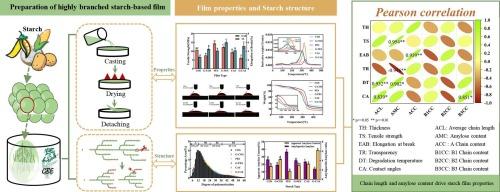Correlation analysis of starch molecular structure and film properties via rearrangements of glycosidic linkages by 1,4-α-glucan branching enzyme
IF 10.7
1区 化学
Q1 CHEMISTRY, APPLIED
引用次数: 0
Abstract
The functional characteristics of starch films are significantly influenced by the amylose content and the distribution of the amylopectin chain length. This work used 1,4-α-glucan branching enzyme to molecularly reconstruct corn, pea, and cassava starch in order to examine the association. Films made of both natural and enzyme-modified starch were produced using the casting method. The study investigated the variations in starch films properties and explored the relationship between starch molecular structure and film qualities by correlation analysis. The results showed a significant positive connection (r = 0.954) between the tensile strength and amylose content, as well as a positive correlation (r = 0.939) between the A chains and the elongation at break. The average chain length (r = 0.932) and amylose content (r = 0.902) showed a positive correlation with the degradation temperature, whereas the amylose content (r = −0.946) showed an adverse correlation with the transparency. The B3 chain (r = 0.851) and the average chain length (r = 0.839) both exhibited a positive connection with its contact angle. As a result, our study thoroughly assesses how starch structure affects the characteristics of starch films and offers a fundamental modification pathway for the development of new application areas.

通过 1,4-α-葡聚糖分支酶的糖苷键重排分析淀粉分子结构与薄膜特性的相关性
淀粉膜的功能特性受到直链淀粉含量和直链淀粉链长分布的显著影响。本研究使用 1,4-α 葡聚糖分支酶对玉米、豌豆和木薯淀粉进行分子重构,以研究两者之间的关联。采用浇铸法制作了由天然淀粉和酶修饰淀粉制成的薄膜。研究调查了淀粉薄膜特性的变化,并通过相关分析探讨了淀粉分子结构与薄膜质量之间的关系。结果表明,拉伸强度与淀粉含量之间存在明显的正相关(r = 0.954),A 链与断裂伸长率之间也存在正相关(r = 0.939)。平均链长(r = 0.932)和直链淀粉含量(r = 0.902)与降解温度呈正相关,而直链淀粉含量(r = -0.946)与透明度呈负相关。B3 链(r = 0.851)和平均链长(r = 0.839)均与其接触角呈正相关。因此,我们的研究深入评估了淀粉结构如何影响淀粉薄膜的特性,为开发新的应用领域提供了一条基本的改性途径。
本文章由计算机程序翻译,如有差异,请以英文原文为准。
求助全文
约1分钟内获得全文
求助全文
来源期刊

Carbohydrate Polymers
化学-高分子科学
CiteScore
22.40
自引率
8.00%
发文量
1286
审稿时长
47 days
期刊介绍:
Carbohydrate Polymers stands as a prominent journal in the glycoscience field, dedicated to exploring and harnessing the potential of polysaccharides with applications spanning bioenergy, bioplastics, biomaterials, biorefining, chemistry, drug delivery, food, health, nanotechnology, packaging, paper, pharmaceuticals, medicine, oil recovery, textiles, tissue engineering, wood, and various aspects of glycoscience.
The journal emphasizes the central role of well-characterized carbohydrate polymers, highlighting their significance as the primary focus rather than a peripheral topic. Each paper must prominently feature at least one named carbohydrate polymer, evident in both citation and title, with a commitment to innovative research that advances scientific knowledge.
 求助内容:
求助内容: 应助结果提醒方式:
应助结果提醒方式:


